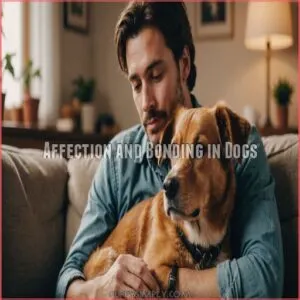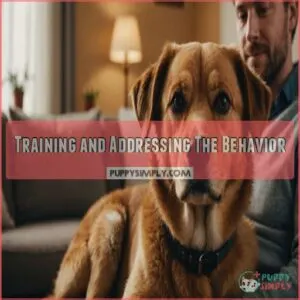This site is supported by our readers. We may earn a commission, at no cost to you, if you purchase through links.
 Why does your dog sit on you? It’s a common question with multiple answers!
Why does your dog sit on you? It’s a common question with multiple answers!
They might be seeking warmth, especially if you’re a cozy human heater. It could be a dominance display, a way of marking you as theirs. Or, simply, they adore you and want to be close.
Sometimes, it’s a comfort thing – a furry little anxiety reducer. Smaller breeds, like Chihuahuas, are especially prone to this.
Understanding your dog’s motivations is key to a happy relationship. Want to learn more about deciphering your dog’s unique behaviors? There’s much more to uncover…
Table Of Contents
- Key Takeaways
- Reasons Why Dogs Sit on Owners
- The Role of Warmth and Comfort
- Affection and Bonding in Dogs
- Training and Addressing The Behavior
- Trends and Other Dog Behaviors
- Frequently Asked Questions (FAQs)
- Why does my dog sit on Me?
- Why do dogs sit on their owners?
- Why do small dogs sit on US?
- What does it mean if a dog sits on You?
- What does it mean for a dog to sit on you?
- Why does my dog sit on me when I’m laying down?
- Why does my dog always come sit on me?
- How do you know if your dog is imprinted on you?
- Does sitting on owners indicate health issues?
- How can sitting affect my dogs posture?
- Is this behavior linked to separation anxiety?
- Do certain diets influence this sitting behavior?
- Can specific toys redirect their sitting habit?
- Conclusion
Key Takeaways
- Understand that your dog sits on you for warmth, comfort, or a sense of security, showing their love and bonding instincts.
- Recognize that while sitting on you can be a sign of affection, it might also be related to territorial behavior through scent marking.
- Pay attention to your dog’s body language to determine if their behavior is related to anxiety, seeking reassurance and safety in your proximity.
- Use positive reinforcement to guide your dog toward preferred habits by utilizing techniques such as clickers and markers to pinpoint desired behaviors, as seen in operant conditioning methods. Rewarding them when they choose their designated spot instead of your lap.
Reasons Why Dogs Sit on Owners
When your dog plops onto your lap, it’s more than just seeking a comfy spot; it’s a behavior rooted in their instincts as pack animals and their need for security.
Understanding these reasons can help strengthen the bond between you and your dog, ensuring a happy and harmonious relationship.
Pack Animals and Safety
When your dog plunks down on you, it’s tapping into its instinctual pack behavior.
Dogs, being pack animals, often seek their human’s lap for a sense of safety and security.
This isn’t just cute; it’s dog communication at its best.
By sitting on you, your pup might be showing dominance displays or marking its territory, blending dog behavior with affection.
Strengthening The Bond
Your dog’s choice to sit on you isn’t just about safety; it’s a heartfelt gesture for strengthening the bond you share.
Think of it as a bonding exercise in dog affection.
By sitting on you, your furry friend seeks physical closeness, encouraging trust and communication.
It’s dog love 101—like a cozy chat over coffee, building comfort and fostering dog bonding.
Security and Anxiety
Spotting canine anxiety? Your dog might plop down on you for comfort and security. Here’s why:
- Separation Anxiety: They feel uneasy alone, so your presence calms them.
- Fearful Behaviors: Sitting on you helps them feel safe from stress triggers.
- Stress Relievers: Dogs find your lap a safe space for anxiety management.
Understanding these signs helps in addressing pet anxiety.
Showing Affection and Seeking Attention
Shifting from anxiety, when your pooch plants itself on you, it’s all about love and grabbing some attention.
Dogs thrive on affection, and they may plop down on you to soak up every bit of your attention, often seeking comfort with familiar objects like their favorite cozy dog blankets.
It’s their way of saying, “Hey, notice me!”
Understanding dog body language helps in distinguishing these attention-seeking behaviors from genuine alerts.
Smaller Breeds and Lap Dogs
Having a lap dog? It’s completely normal for smaller breeds to love cuddling! They’re naturally more prone to this behavior. Why?
- They often seek warmth and comfort.
- It’s a way to bond with you.
- Small dogs may feel safer nestled close, especially if they’re under 20 pounds and have an affectionate nature like common lap dog breeds.
Proper lap dog care includes understanding their unique needs. Good lap dog training focuses on gentle guidance, not forceful removal. Remember, lap dog health is just as important as any other breed!
Spreading Scent and Marking Territory
Ever wonder why your dog plops down on you? It’s all about scent marking and territory defense! Dogs often sit on their owners to spread their scent, a natural form of dog communication. This behavior asserts dominance and helps keep other pets at bay.
| Behavior | Reason | Impact |
|---|---|---|
| Scent Marking | Spread personal scent | Mark territory |
| Territory Defense | Guard against other animals | Feel secure |
| Dominance Display | Show leadership | Gain respect |
Comfort and Companionship
After marking their scent, dogs cozy up for comfort and companionship.
This behavior isn’t just instinct—it’s a sweet gesture of bonding.
Your furry friend loves being close, providing warmth and emotional support.
Here’s why they do it:
- Dog cuddles mean owner bonding.
- Acts as pet therapy and stress relief.
- Offers emotional support for you both.
Asserting Dominance
When your dog sits on you, it might be brushing up on its alpha dog skills.
While comfort with you is nice, this behavior could signal an attempt to be top dog in the pack hierarchy.
Observing dog body language helps you see if they’re asserting dominance.
Encourage proper socialization, including addressing potential issues like littermate syndrome problems, and use training techniques to address this dog behavior problem effectively.
The Role of Warmth and Comfort
Warmth isn’t just comforting; it’s essential for dogs, especially when cold weather bites. You might notice your furry friend snuggling up to you, a human heater in their eyes. Here’s why:
- Dogs’ Body Temperature: Dogs have a higher body temperature than humans. Sitting on you aids in cozy temperature regulation, acting like a living blanket.
- Blanket Preference: Many dogs love being tucked in, and your lap offers that irresistibly snug blanket feel.
- Comfort Seeking: Just like we reach for that comfy dog toy, your dog craves the soothing hug of warmth when temperatures drop.
These habits aren’t just cute; they’re instinctive, cementing your role as their cozy spot!
Affection and Bonding in Dogs
Your dog sitting on you isn’t just a quirky habit; it’s a heartfelt way to express loyalty and affection.
This behavior reflects a strong bond, showing their love and appreciation, especially in breeds that thrive on physical closeness and bonding.
Loyalty and Love for Owners
Feeling like a warm blanket, your dog’s presence offers more than comfort.
They sit on you not just for warmth, but to express affection and loyalty.
This behavior reveals their emotions, their body language, and their unique loyalty cues.
Dogs show love this way, keeping the owner-dog connection tight.
A dog expert might call this an adorable gesture of love.
Strong Bond Between Dog and Owner
Your dog’s loyalty shines through in their desire for closeness.
That’s a big part of why they sit on you!
It’s all about building that owner-dog trust.
Think of it as:
- A comfy spot.
- A way to show they’re part of your pack.
- A display of dog communication.
This behavior speaks volumes about your bond, showcasing positive dog behavior and strong dog psychology, as can be seen in various dog sitting positions, such as the lazy sit or sitting like humans, which reveal emotional well-being. This behavior speaks volumes about your bond, showcasing positive dog behavior and strong dog psychology.
It’s a win-win!
Showing Love and Appreciation
From that strong bond, dogs express love and appreciation with delightful gestures.
When your furry friend plants themselves on you, they’re not just seeking a comfy spot.
With dog communication, tail wags, affectionate touches, and even vocalizations, they’re saying, "You’re my favorite human!"
This display reinforces the affection and connection you share.
| Behavior | Meaning |
|---|---|
| Tail wags | Happiness and excitement |
| Body language | Calmness and trust |
| Affectionate touches | Love and bonding |
| Vocalizations | Communication and joy |
| Sitting on you | Appreciation and warmth |
Physical Closeness and Affection
While dogs show appreciation through playful antics, they’re also fond of physical closeness and affection.
Dogs see sitting on you as a bonding ritual, a love language of sorts.
Providing a comfortable resting place, like shopping for the perfect dog’s cozy bed, can encourage this behavior.
It’s their way of saying, "We’re in this together."
Embracing this dog cuddling habit can reinforce your bond, giving your furry friend comfort and security through simple physical touch.
Affectionate Breeds and Bonding
Fido’s snuggling habit isn’t just about warmth—it’s a heartfelt gesture from affectionate breeds.
You might wonder if Rover uses cuddling as his love language.
Pay attention to bonding signs; they’re like your dog’s little love notes.
- Affectionate breeds often seek closeness.
- Such cuddling habits strengthen bonds.
- Breed comparisons highlight varied attachment styles.
Training and Addressing The Behavior
To train your dog to stop sitting on you, reward them for sitting in their own space, and consistently avoid reinforcing the undesired behavior.
If this habit continues to pose challenges or develops into aggression, consider seeking professional help from a trainer or behaviorist.
Rewarding Desired Behavior
Dogs show love, cuddling on your lap and basking in warmth.
Encouraging them with positive reinforcement helps.
Use training techniques like clicker training and treat rewards.
Reward your pup when it sits in a designated spot.
Consistent commands guide behavior gently, steering them to preferred habits.
| Technique | Benefit |
|---|---|
| Clicker Training | Quick response |
| Treat Rewards | Motivation boost |
| Consistent Commands | Clear expectations |
| Dog Bed Training | Comfort and reliability |
| Patience | Builds trust |
Avoiding Reinforcement of Undesired Behavior
Switch gears to tactics that prevent unwanted behaviors.
Avoid encouraging acts you’d rather not see.
Here’s how:
- Ignore the behavior – Don’t react when your pup hops onto your lap uninvited.
- Redirect attention – Offer a toy or a new activity.
- Employ positive reinforcement – Reward your dog only when they choose their own space.
Consistency in Training
Think of training like building a habit; it takes time.
Use positive reinforcement—rewards work wonders!
Patience is essential; don’t get discouraged by setbacks.
Repetition helps your pup learn.
A little time commitment now pays off big in the long run, building a stronger bond.
Remember, positive reinforcement, with consistent rewards and patience, makes training a success.
Discouraging The Behavior
Imagine this: your furry pal decides you’re the comfiest spot in the house.
To discourage such behavior, consistency is key.
Use dog-proof furniture and offer alternatives to sitting, like a cozy bed.
Reward your dog with positive reinforcement when they choose the right spot.
Gentle guidance makes a world of difference, turning this into a paw-sitive habit!
Seeking Professional Help
If your dog’s affection feels more like a dominance display or triggers aggressions, it might be time to seek professional help.
A qualified trainer can provide invaluable training tips.
Similarly, a vet’s advice may also consider the possibility of underlying temperament issues related to Shih Tzu aggression signs. a vet’s advice confirms there are no underlying health issues.
Professionals offer behavior modification strategies designed specifically for your furry friend, balancing affection and boundaries.
Trends and Other Dog Behaviors
When you understand the trends of why dogs walk in circles around their owners due to excitement and anticipation why dogs circle, and other dog behaviors, you’ll see that certain breeds like Chihuahuas and Shih Tzus are more inclined to sit on their owners.
Environmental factors, such as living in colder climates, can also influence this behavior, along with other common canine actions like ear pinning and pawing.
Breed-Specific Behavior
After teaching your dog not to jump on you, consider breed-specific behaviors.
Dogs’ actions can be driven by their ancestral history and instincts, and sometimes even their age, with younger dogs often exhibiting Frenetic Random Activity Periods.
- Lap dog tendencies: Small breeds like cuddling.
- Herding instincts: Collies love rounding people up.
- Tibetan Mastiffs, like other protective aggression dog breeds, often exhibit loyal guarding instincts. Guard dogs keep watch from your lap.
- Prey drive: Some hounds follow scent trails right over you.
Environmental Factors and Behavior
Understanding your dog’s behavior involves considering environmental factors like their age and your lifestyle.
Living space can influence their need for socialization and warmth.
Imagine chilly mornings prompting cuddles or a cozy apartment fostering closer bonds.
Climate impact can’t be ignored—cold weather might’ve your dog seeing you as a personal heater! These nuances shape how your furry friend interacts with you daily.
Other Common Dog Behaviors
You’ve explored environmental factors, but what about other dog behaviors?
Understanding a wagging tail isn’t just about happiness—it’s a window into canine body language.
Have you noticed your dog’s playful bark or how they sleep?
These behaviors speak volumes. Whether it’s barking habits or playfulness, each one reveals your pup’s personality and offers clues about their needs.
Frequently Asked Questions (FAQs)
Why does my dog sit on Me?
Your dog sits on you because they’re seeking warmth, comfort, or a sense of security.
It strengthens your bond, affection, and sometimes even marks territory.
Plus, it’s an excellent way to get some cuddle.
Why do dogs sit on their owners?
When dogs sit on you, it’s a mixed bag of love and security.
They find comfort and warmth, mark their territory, or seek attention.
This behavior strengthens your bond and helps them feel safe and connected.
Why do small dogs sit on US?
Small dogs often sit on you to feel secure and warm.
This behavior stems from their instincts as social animals, offering them a sense of belonging and affection.
Plus, who doesn’t enjoy a cozy lap companion?
What does it mean if a dog sits on You?
A dog sitting on you often shows love, a desire for warmth, or comfort seeking.
It’s their way of bonding, feeling secure.
Dogs might also sit on you to spread their scent and mark territory.
What does it mean for a dog to sit on you?
A dog sitting on you shows affection, seeks warmth, or asserts dominance. It’s a pack behavior, strengthening your bond. Sometimes, it’s just comfy! Consider your dog’s breed and age.
Why does my dog sit on me when I’m laying down?
Imagine your dog perched on you like a royal throne because it craves warmth, comfort, and affection.
This loving gesture strengthens your bond.
It also eases anxiety.
The gesture is often driven by instinct or a desire for closeness.
Why does my dog always come sit on me?
Your dog finds comfort and security in sitting on you.
It’s a sign of affection and bonding, helping them feel safe and protected.
Plus, they enjoy sharing warmth and spreading their scent to mark territory.
How do you know if your dog is imprinted on you?
In a world where bonds transcend words,
your dog shows trust and loyalty by always being near you, following you around, gazing at you lovingly, and responding to your emotions.
These signs reveal a deep, unbreakable connection.
Does sitting on owners indicate health issues?
Sitting on you usually means your dog seeks comfort, warmth, or security.
While it’s typically normal behavior, sudden changes in this habit could hint at health issues.
Consult a vet if concerned about any new or unusual behaviors.
How can sitting affect my dogs posture?
Persistent perched pooches can place pressure on posture.
When your dog sits frequently, it might lead to uneven weight distribution, potentially causing joint strain or discomfort over time.
Encouraging varied positions can help maintain their spinal health and comfort.
Is this behavior linked to separation anxiety?
Your dog’s behavior isn’t automatically linked to separation anxiety. It could be for comfort, warmth, or affection. However, if it’s excessive, consider other causes. Consult a vet if worried.
Do certain diets influence this sitting behavior?
Diet doesn’t directly shape your dog’s sitting behavior, but it affects energy levels and overall health, which might influence how often they seek comfort or warmth.
Ensuring a balanced diet helps maintain their general well-being.
Can specific toys redirect their sitting habit?
Did you know dogs spend nearly 54% of their day seeking affection?
Using interactive toys like treat dispensers or puzzle feeders can help redirect their sitting habits, keeping them engaged, active, and away from your lap.
Conclusion
Imagine your dog sitting on you like the family TV remote; they want control, comfort, and closeness.
Understanding why your dog sits on you helps strengthen your bond.
Whether it’s for warmth, protection, or pure love, these behaviors reflect their pack instincts and emotional needs.
Be attentive to cues, and use training to manage unwanted behaviors.
Deciphering these actions reveals a lot about your furry friend, enhancing both communication and companionship.










